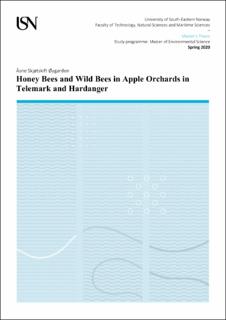| dc.description.abstract | The decline in bee species richness and abundance has been a global concern in the past few decades because of our dependence on bees as agricultural pollinators. The loss of habitat is one of the main factors in this development. The expansion of agriculture with unsuitable nesting and foraging areas is a detriment especially to wild bee species. European honey bees (Apis mellifera) live in apiaries and are generalists who can feed off many kinds of flowers, so they are not as vulnerable as wild bees, but they face other challenges in line with parasites and pesticides. There are several reasons why honey bees are popular pollinators in agriculture: population densities are easily manipulated, they can be placed anywhere, and they pollinate many different flowers. The competition between honey bees and wild bees is especially apparent when flower levels are low, and there is larger niche overlap between the bee species.
Because of all these factors, honey bees are expected to be the most abundant bee species in apple orchards. A survey of bees in apple orchards in Hardanger and Telemark showed that the European honey bee is the most abundant of all bee species present – with more individuals than all other bee species combined – and this was true for all five orchards sampled. The second largest group included several species of bumble bees (Bombus spp.), and the rest of the identified bees consisted of mining bees (Andrena spp.) (two species), mason bees (Osmia sp.) and long-horned bees (Eucera sp.). Apart from the latter, all are known pollinators commonly found in apple orchards.
Honey bees dominated the apple orchards in terms of abundance, but research shows that there might be advantages to having more diverse and abundant wild bees present as well. Many of them are effective pollinators of apple trees, and are also actively foraging in lower temperatures than honey bees, which can be an advantage in early spring apple blossoms. | en_US |
